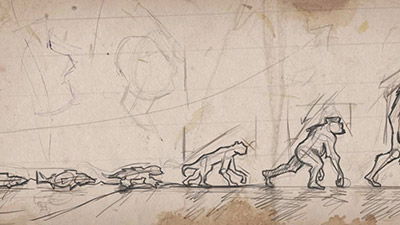
Missing Link May Have Shuffled on Its Way to Bipedalism
ScienceDaily: “Did Walking On Two Feet Begin With A Shuffle?” Might the missing link have done a dance move on its way to bipedalism?
Here’s the story: a few million years ago, an ape was standing on its hind legs to reach a piece of yummy fruit. Then, spotting another nearby, it shuffled toward it on two legs rather than dropping to all fours. Voilà! We just proved evolution.
Walking is too energy inefficient for chimps.
That’s the tall tale told by researchers from the University of Washington and Johns Hopkins University, who have developed a model that suggests that upright shuffling developed before upright walking. The study was published in the American Journal of Physical Anthropology.
Here’s the basic idea: since “our last common ancestor probably had a body like that of a chimp . . . chimps are a good place to start,” explained University of Washington anthropologist Patricia Kramer. Of course, evolutionists believe that chimpanzees are also our closest living relative, although they walk on all fours. Chimps may sometimes move on two feet, but only for a short distance; walking is too energy inefficient for chimps, otherwise, so they stick to all fours. Kramer gives the analogy of a baby learning to walk: the baby may wobble along a few steps, but if the baby wants to go across the room, he or she will instead crawl.
If the team had stopped at that point, creationists could applaud the research: apes rarely walk because it is rarely energy efficient, only being so for very short movements (usually less than 3 ft [1m]). It confirms that apes weren’t designed to go around on two feet only.
But, of course, the evolutionary interpretation is a completely unnecessary tack-on to the research; and in the case of this study, it opens the research up to attack.
First of all, as we said, the research is an explanation of the observed behavior of apes, and actually shows the limits to ape bipedalism (that is, it runs counter to the supposed ape-to-human connection). Furthermore, this is the “built-in” (designed) behavior of apes; for the evolutionary tale to be true, some ancient apes needed to undergo mutations that actually changed the skeletal structure and made it energy efficient to walk on two feet for longer distances.
Evolutionists indeed have a story, the great “scripture” of natural selection over eons and eons.
Second, an animal changing its method of locomotion temporarily in no way indicates that it may evolve in a particular direction; other animals (household pets, for example), often stand on two feet—and even walk, momentarily—when a tasty morsel is dangled above them. If an aberrant group of evolutionists believed humans evolved from canines, they could use the same research as Kramer’s group, but instead base the study on household pets instead of chimpanzees, and they would arrive at the same conclusions.
Finally, evolutionists have to weave a story about how bipedalism/apemen emerged because the evidence for such a transition just isn’t there. In fact, even the news release on the research admits as much:
Because of a huge gap in the fossil record that hides when humans split off from other primates, Kramer and co-author Adam Sylvester . . . used the chimpanzee as a way of looking into the past and testing other researchers' ideas about the origins of bipedalism.
Evolutionists indeed have a story, the great “scripture” of natural selection over eons and eons. Creationists have a history—one that lines up with the facts and is the Word of our Creator.
For more information:
Remember, if you see a news story that might merit some attention, let us know about it! (Note: if the story originates from the Associated Press, Fox News, MSNBC, the New York Times, or another major national media outlet, we will most likely have already heard about it.) And thanks to all of our readers who have submitted great news tips to us.
(Please note that links will take you directly to the source. Answers in Genesis is not responsible for content on the websites to which we refer. For more information, please see our Privacy Policy.)
Recommended Resources

Answers in Genesis is an apologetics ministry, dedicated to helping Christians defend their faith and proclaim the good news of Jesus Christ.
- Customer Service 800.778.3390
- Available Monday–Friday | 9 AM–5 PM ET
- © 2025 Answers in Genesis





